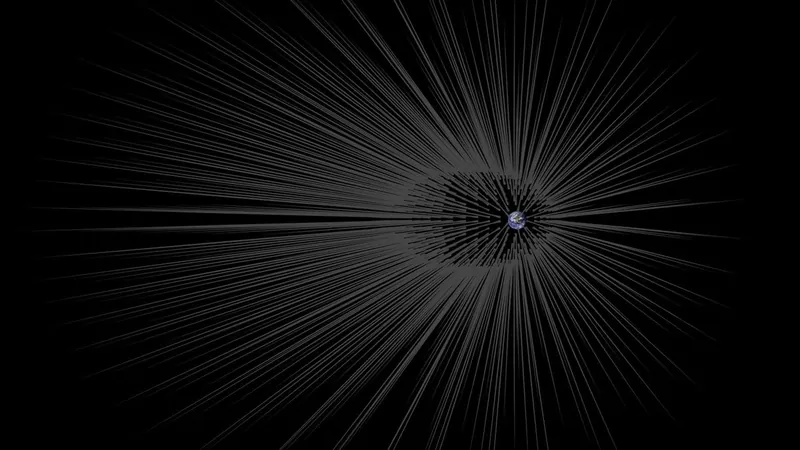
Is Something 'Fuzzy' Lurking at the Heart of the Milky Way? Scientists Discover Possible Dark Stars!
2025-01-14
Author: Ling
Introduction
A groundbreaking study suggests that galaxies, including our own Milky Way, may be anchored by mysterious "dark stars," composed of elusive particles at their cores. This revelation stems from the ongoing quest to understand dark matter—an invisible substance believed to make up a significant portion of the universe's mass yet remains an enigma to scientists.
The Mystery of Dark Matter
While astronomers possess substantial evidence indicating the dominance of dark matter in galaxy formations, the precise nature of this mysterious mass continues to baffle researchers. Historically, the leading theory posited that dark matter consists of heavy particles that seldom interact with light or conventional matter. However, this theory struggles to account for the surprisingly low densities observed in galaxy centers. Simulations typically suggest that these particles should clump together, resulting in much denser galaxy cores than what we observe.
The Concept of Fuzzy Dark Matter
Enter the intriguing concept of "fuzzy" dark matter. This theory proposes that dark matter particles could be exceptionally light—billions of times less massive than the neutrino, which is the lightest known particle. These lightweight particles exhibit wave-like properties that scale up in the cosmic arena, allowing them to accumulate into vast clumps or so-called dark stars.
Characteristics of Dark Stars
What's astonishing is that these dark stars could extend over thousands of light-years while maintaining relatively low mass. As a potential core structure for galaxies, they could explain why we see less density at the galactic center while still providing a considerable portion of a galaxy's overall mass.
Galactic Composition
Nevertheless, galaxies are not solely composed of dark matter. The presence of ordinary matter, primarily found in the forms of stars and gas clouds, also plays a crucial role. Understanding the interactions between fuzzy dark matter and this ordinary matter is essential to validate the dark star hypothesis.
Recent Findings and Study
In a study released on December 17, 2024, an international consortium of astrophysicists delved into how galaxies may evolve under the influence of fuzzy dark matter. They created a simplified toy model featuring two primary components: a significant volume of fuzzy dark matter and a smaller quantity of ideal gas.
Results of the Model
Their findings revealed that, despite initial erratic movements, the fuzzy dark matter began to coalesce into a massive central clump, surrounded by diffuse clouds of the dark matter. Simultaneously, the gas component intermixed with this dark matter core, forming what the researchers referred to as a "fermion-boson star." Remarkably, this star could stretch up to an astounding 10,000 light-years in diameter, remaining almost entirely invisible, save for the faint glow emitted by the gaseous material throughout it.
Importance of the Model
This model proves critical as it mirrors the expected characteristics of a galactic core—demonstrating higher, yet not excessive, densities of normal matter, thereby affirming a fundamental prediction of the fuzzy dark matter theory.
Looking Ahead
As scientists take the next steps toward more intricate models to further explore these enigmatic dark stars, they aim to align their theoretical predictions with actual astrophysical observations. The potential to unravel the secrets of dark matter and the composition of our universe is closer than ever! Stay tuned, as the cosmos may hold even more surprises in store!


 Brasil (PT)
Brasil (PT)
 Canada (EN)
Canada (EN)
 Chile (ES)
Chile (ES)
 Česko (CS)
Česko (CS)
 대한민국 (KO)
대한민국 (KO)
 España (ES)
España (ES)
 France (FR)
France (FR)
 Hong Kong (EN)
Hong Kong (EN)
 Italia (IT)
Italia (IT)
 日本 (JA)
日本 (JA)
 Magyarország (HU)
Magyarország (HU)
 Norge (NO)
Norge (NO)
 Polska (PL)
Polska (PL)
 Schweiz (DE)
Schweiz (DE)
 Singapore (EN)
Singapore (EN)
 Sverige (SV)
Sverige (SV)
 Suomi (FI)
Suomi (FI)
 Türkiye (TR)
Türkiye (TR)
 الإمارات العربية المتحدة (AR)
الإمارات العربية المتحدة (AR)